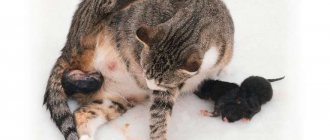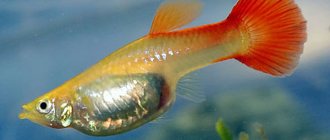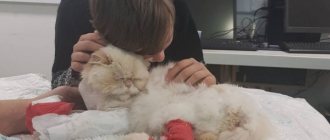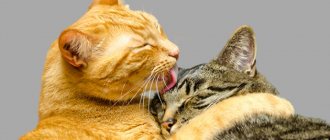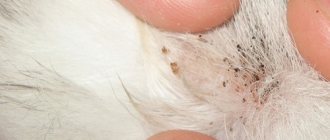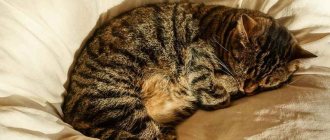12278Administration
Waiting for kittens from a pet is a trembling and responsible event, especially if the cat is preparing to become a mother for the first time. The question of when the kittens of a pregnant cat begin to move worries, perhaps, all owners - after all, this is a sure sign that the pregnancy is proceeding normally and the health of the babies and mother is in perfect order.
On average, the gestation period for kittens is two months. Depending on the breed and size of the animal, as well as some genetic characteristics, these periods can vary from 58 days to 72. The more kittens in the womb, the shorter the duration of pregnancy, the sooner they will begin to move. Accordingly, 1-2 babies will be born a little faster.
Signs of early pregnancy
Waiting for kittens is a condition that almost every cat experiences, whose owners are determined to “replenish” the family and have bred. Like any process occurring in the body, pregnancy is associated with changes in the animal’s mood, behavior and appearance. Sometimes it is difficult for owners, especially inexperienced ones, to determine whether a cat is planning to have kittens. Fortunately, there are a number of signs that can help loving owners decide whether their pet will become a mother, and find out this in the early stages.
Termination of heat
Unlike dogs, estrus in cats can occur even 2 times a month (usually once every 2-3 months), which can be a signal of readiness for mating. Usually this sign is characteristic of a sexually mature female, but if she is pregnant, estrus may be absent in the early stages. You may notice that the animal does not ask to go outside, does not make uterine sounds, behaves relatively calmly and has no interest in cats. If this is exactly the case, your cat may well be in the “position” after meeting her groom.
Changing nipple color
Very often, the first symptom can be seen by looking at the pet's nipples, which can change their color, becoming pink. If the animal is expecting kittens for the first time, this sign is especially noticeable. In individual cases, not all nipples change color, but only some.
Drowsiness
If before pregnancy your pet was playful and active, then after mating you may notice that she began to lie down on her bedding for a long time. The animal's sleepy state is caused by changes in the hormonal system. This process is also accompanied by weakness. If you see a similar symptom in your pet, do not rush to get scared - most likely, your pet is not sick, but is simply expecting kittens.
Change in appetite
In the early stages of pregnancy, it happens that the cat eats too little. In addition, she may feel nauseous, which is typical during this difficult period for her. Fortunately, nothing lasts forever, so vomiting does not last long, and not all cats have it.
When does a pregnant cat start to move kittens?
When kittens begin to move in the belly of a pregnant cat, this indicates that the pregnancy itself is proceeding without problems, which is why it is important to monitor the condition and behavior of the pet, especially if she is bearing offspring for the first time. Typically, movement occurs at 6 weeks, when the kittens' muscular and nervous systems are developing. In this way they warm up the motor system.
Late signs of pregnancy
It may happen that you did not immediately notice changes in the behavior of your furry pet, because the first signs of pregnancy in cats may not be too bright. Don't worry: you still have time to prepare for the joyful event - the appearance of kittens. However, if you are still wondering how to find out that a cat is pregnant, its state in the later stages will certainly help you decide.
Weight gain, overeating
If at the beginning of the path to future motherhood the striped pet did not show much love for food and ate little by little, then after several weeks of pregnancy her appetite becomes simply brutal. This can be determined by the amount of food eaten in the bowl, which will be required much more than usual.
Abdominal enlargement
After several weeks of pregnancy, your cat's belly will certainly begin to grow, which is the main sign of her condition. Due to the increase in the size of the kittens, they will soon be able to be felt, but this must be done very carefully, because the babies are very vulnerable.
Changing nipple size
If at the beginning of pregnancy the cat may only have redness in this area, then in the later stages you may notice an enlargement of the nipples. This is due to the fact that the cat will have to feed the kittens milk and the body is already preparing for this. This sign makes it possible to determine the pregnancy of a pet almost certainly a couple of weeks after fertilization.
Uncharacteristic behavior
As we noted earlier, hormonal levels, which invariably change during pregnancy, especially the first, can also affect the cat’s behavior. So, if she was previously uncommunicative and prone to loneliness at home, now the pet can become affectionate and demand reciprocal attention. After fertilization, many cats tend to care for someone (such as other pets in your home). The opposite situation also happens, when a once affectionate cat becomes aggressive and hides in the corners. There is nothing wrong with this: she only protects her offspring from imaginary enemies.
Nesting
Speaking about what other signs of pregnancy there are in cats, we can also note the animal’s unusual desire to create a safe territory for future kittens. As a rule, the “nest” in which she and the babies will be is chosen very carefully: warm, without drafts, in silence. At this stage, the owner should be careful, as the animal may well take a fancy to his bed. After pregnancy, the pet is sensitive to everything related to the safety of the kittens, so a warm place on the owner’s bed will suit her quite well. Well, it’s important not to miss this moment and help your cat set up a “nest” for kittens away from your bedroom.
If for one reason or another you still doubt that your pet is pregnant, it makes sense to consult a veterinarian. The doctor will not only accurately answer this question, but also, with the help of modern technologies, will determine how many kittens the expectant mother is carrying. In addition, after the examination, the doctor will rule out the possibility of cat diseases (some diseases may cause symptoms such as excess weight and abdominal enlargement) and the so-called false pregnancy, in which all the signs are present, but there are still no embryos.
If the cat’s “interesting position” is confirmed, the specialist will tell you how to care for your pet during pregnancy and after birth. Paying close attention to your beloved cat will help you not only make sure whether kittens are planned, but also take proper care of the expectant mother and her furry babies.
Shows of affection
Do cats sense their owner's pregnancy in addition to smell? Most often, women note that their pets strive to lie down on their stomachs, purring loudly, even if such behavior was previously unusual for the pet. Animals show such interest in the belly of pregnant women not only in relation to their owners.
A cat can behave in a similar way towards a guest who is in a position. The desire to lie down on their stomach or nearby, so as to come into contact with it, is characteristic not only of cats, but also of cats. Sometimes a wayward and not very affectionate animal begins to show special tenderness to the abdominal area of its owner.
But what exactly is it about these areas that attracts animals so much? If the interest in the breasts can be easily explained by the fact that its enlargement and swelling causes even a slight increase in temperature, to which cats are very sensitive. In addition, the transformations that occur in the mammary glands in order to adapt them to milk production also contribute to the appearance of special odors, elusive to others, but attractive to animals.
But how to explain the cat's interest in the belly of pregnant women? Perhaps they feel changes in pressure, temperature, muscle tone, some subtle vibrations, or energy that no equipment has yet captured? One can only guess about this. There are many speculations as to whether cats can feel their mistress’s pregnancy on an energetic level. Sometimes these animals are endowed with psychic qualities, but there is no direct evidence of this.
We invite you to read: Cat anatomy interesting facts
Video “Cats. Life before birth"
This video will talk about the conception and birth of kittens.
Sorry, there are no surveys available at this time.
Was this article helpful?
Thank you for your opinion!
The article was useful. Please share the information with your friends.
Yes (100.00%)
No
X
Please write what is wrong and leave recommendations on the article
Cancel reply
Rate the benefit of the article: Rate the author ( 4 votes, average: 5.00 out of 5)
Discuss the article:
How does a cat give birth?
You can determine that labor is about to begin based on several signs:
- pussy completely refuses to eat;
- shows increased anxiety;
- her body temperature decreases;
- You may notice water breaking, which is grey-red in color.
As a rule, after the water breaks, the period of contractions begins. They should last about an hour, after which the first newborn kitten will be born. However, the period of contractions may drag on. The norm is considered to be labor within 24 hours from the moment the water breaks. If, after 5 hours from the moment your water breaks and contractions begin, your cat has not been able to give birth to a single kitten, you should seek help from a specialist.
It is also worth resorting to veterinary help if more than four hours have passed after the birth of the first baby, and the second kitten is not born. As a rule, the interval between the birth of kittens is 10-15 minutes. During this period, you can give the woman in labor warm milk.
Kittens that are born are connected to the placenta by the umbilical cord. After the baby is born, the cat independently gnaws the umbilical cord and eats it. The mother begins to lick the newborn kitten.
- stroke the cat's belly and back - this may cause contractions;
- if the baby is stuck in the birth canal, you should carefully help him out;
- You should not pull the kitten by the head - this could cause it to die;
- gently pull the baby by the hind legs, alternately to the right and to the left;
- pull the kitten only along the mother’s body;
- Use your other hand to support the mother cat's belly.
READ Miscarriage in a cat: causes and help
After giving birth, your pet will probably need rest and peace. Try to provide her with everything she needs: food, water and toilet near the place where the kittens are born. It is worth protecting this place from prying eyes, do not let strangers near the kittens -
https://www.youtube.com/watch?v=YJRVqM4WB4k
for your newborn babies. Otherwise, she will become nervous and may decide to move the kittens to a safer place.
Be patient, very soon the kittens will get stronger and leave the warm “nest” of their mother, setting off to explore such a new and unknown little world for them. A cat's pregnancy is a great time to wait for the birth of offspring.
